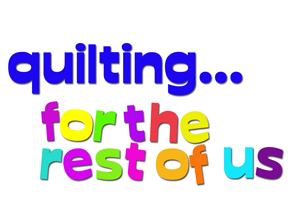I admit: I can get obsessive sometimes.
Yes, I'm so determined to get more comfortable with bag-making that I bought Building Better Bags: Interfacing and Structure with Sara Lawson (of Sew Sweetness).
Nope, still really don't like making bags. Probably never will--it's just not my bag (ar ar ar). For some reason, though, I'm feeling a bit stubborn about making myself get better at it. As I think I've mentioned in previous reviews, one of the big issues when it comes to following patterns and tutorials for bag-making is that I didn't come to sewing from garment-making, I came to it from quilting. I had to learn how to stitch in a straight line and keep an accurate 1/4" seam and that was about it.
So, one of my weaknesses when it came to sewing bags has been a lack of knowledge about interfacings. One doesn't run into interfacings much in the quilting world. I'm figuring it's lucky I had even absorbed the definition of the word from my Mom's years of garment-sewing when we were kids and before we rebelled against wearing homemade clothes--a rebellion, however, that had a happy ending as it's what propelled her into the world of quilting. But I digress.
When I saw Building Better Bags: Interfacing and Structure with Sara Lawson pop up on sale, I decided that although it would probably be a bit like watching paint dry, it was information I should probably have. Plus, I do really like Sara Lawson's bag designs--I'd like to get comfortable enough in my skills that I could tackle some of her more interesting patterns and not end up wanting to throw things or swearing a blue streak through the entire process.
My goals are small, really. Less throwing and swearing. That would be good.
I have to say--the class did have really good information. I do feel like I have a much better understanding now of the variety of interfacings and stabilizers that are available and what each one of them brings to the table. I feel like I could more easily approach some bag patterns and perhaps substitute different innards if I want a different result. So that's all really good--and I'm glad I have the class for reference in later bag-making endeavors. I would have liked Sara Lawson's presentation style to be a little more relaxed in the class, but she did give the information very clearly and in a very easy-to-understand manner.
I immediately felt the benefit of the class, by the way, when I started watching again the Crazy Quilt class with Allie Aller and she referred to the interfacing/stabilizers she used. I knew what she was talking about now!
This is purely an informational/reference class: There are no class projects, although she shows tons of examples from her really wonderful bag designs. (Hence, no pictures to share with this post.) The class materials include an excellent reference chart for stabilizers and interfacings that I'm going to hang on my wall to check whenever a pattern calls for a particular brand that I can't find, or just says the type and I have no idea what they mean.
If you're an old-hand at this kind of thing, you could probably bypass it. But if, like me, you have only passing reference to the fact that there even is such a beast called "Interfacing," you will find this class tremendously helpful. If also, like me, you're a relative newbie on the bag-making scene--take advantage of this class earlier in your journey down this path than I was able to. This information would probably have lessened my frustration level somewhat in my prior bag-making endeavors.
The Basics
- 8 classes, ranging from 10 minutes to 23 minutes, although most are about 12-15 minutes.
- Lesson one is simply a brief introduction of Sara Lawson and Sew Sweetness designs.
- Lesson 2 gives the foundational information about what interfacing is, how to choose and purchase the best one for the job, and how to test it before committing your project to it.
- Lessons 3 through 5 cover the different weights and types of stabilizers in categories, and she gives very helpful tips for how to use each with the most success (tips for sewing, fusing, and so forth).
- Lesson 6 is entitled "Structured Reinforcements" and covers the other types of materials you can use as a stabilizer, how to do a false bottom, and reinforced handles.
- Lesson 7 is about creating and attaching bias binding for seams and how to make and install piping.
- Lesson 8 offers great finishing touches appropriate for any bag design, and how to care for your bags long-term.
So, while not the most exciting class I've ever taken, in terms of the information Building Better Bags: Interfacing and Structure with Sara Lawson presents it's a solid addition to my repertoire. I do recommend it if you've had the same questions swimming in your head as I have!
(Transparency statement: As a Craftsy affiliate, using Craftsy links in this post help support my podcast and blog. Thanks so much!)





















